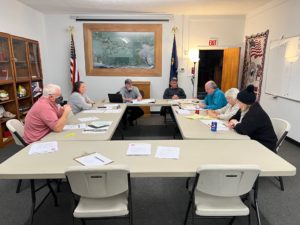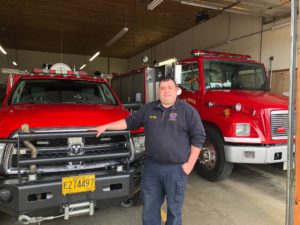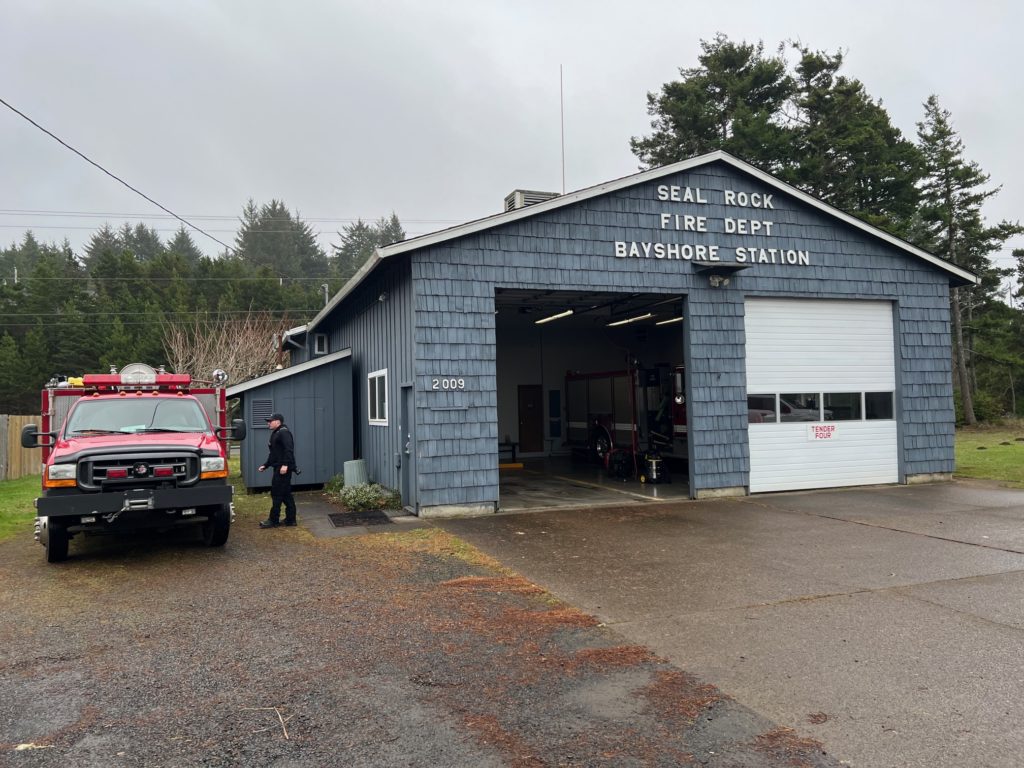
By QUINTON SMITH/YachatsNews.com
Can this marriage be saved?
Does it need to be? Or do they want it to be?
A two-year-old agreement between the Seal Rock Fire District and Central Oregon Coast Fire & Rescue to share firefighters could be unraveling after a sudden shift in directions by a new Seal Rock board and its interim fire chief.
The two fire districts signed an agreement in March 2020 because they were strapped for paid firefighters and volunteers to separately respond to incidents. Each district has four paid firefighters. Waldport has 10 certified volunteers and until recently Seal Rock had none.
The agreement allowed firefighters in the two neighboring departments to work, train and live together and respond to emergencies in either district on a COCF&R engine. That allowed the districts to have three firefighters on duty two shifts a week and two firefighters on one shift per week. Shifts are two days long, followed by four days off.

But a turnover of Seal Rock board members last July brought in a majority who believe the intergovernmental agreement is one-sided, that Seal Rock’s paid staff need to be stationed in the district, and that it can recruit enough volunteers to fill any gaps.
In October, the new board fired the former chief, who insisted that volunteers be certified through the Oregon Department of Public Safety Standards and Training. It just started a search for a new chief and has been contracting since then with Will Ewing as its interim chief. Ewing has had success recruiting volunteers in Toledo and in the Santiam Canyon communities of Detroit and Idanha – but was tarnished this fall for pleading guilty to a domestic violence charge involving his wife.
The latest development followed a Covid-19 exposure during Christmas and New Years that forced firefighters to split and stay at the Central Coast station in downtown Waldport and the Seal Rock station in Bayshore. Things changed again Jan. 6 – even after two days without a firefighter in the Seal Rock station because of two unfilled shifts that caused Central Coast to cover calls without their assistance.
Ewing emailed Central Coast chief Jamie Mason to say that Seal Rock firefighters would remain at the Bayshore station and drive a Suburban to calls – where they would meet up with the COCF&R engine. That changed slightly this week, when Seal Rock firefighters started taking a rescue truck to incidents.
The decision immediately drew criticism from the union representing firefighters in the two districts, Mason and the COCF&R board. They think the split is unsafe, not an efficient use of personnel, and provides better response to emergencies – whether they are in Waldport or Seal Rock.
Ewing and Seal Rock board member Paul Rimola disagree. They say the districts are headed in different directions. Neither is bad, just different, they said.
Seal Rock is smaller, has a smaller tax base and budget, generates one-fourth the emergency calls as Central Coast, and having its firefighters spend most of their time at the station in downtown Waldport led to inattention to its district’s equipment and facilities.
“They weren’t accessible to us … to be working up here,” said Ewing.
Rimola is also unsure that Seal Rock can afford to be going in the same direction that Central Coast appears to be headed.
“We are a rural fire district with a small tax base,” Rimola said. “Taxpayers in this community don’t want to pay more taxes.”
Differences over staffing, volunteers
Mason and the Central Coast board feel it is unsafe to have a single firefighter racing up the highway or along a country road alone in a 40,000-pound engine. Central Coast believes the standard should be two. In more metropolitan departments the minimum is three.
“One person by themselves can’t do what two people are capable of when they are working together,” Mason said in an interview with YachatsNews. “They’re not arriving together. They’re not communicating, they’re not planning.

“If it’s late at night it’s good to have someone watching out for what’s going on,” he said. “Two people together are more important than which station they’re coming from. What if something goes wrong when you get there? There’s no one to help.”
The International Association of Fire Fighters local that represents Seal Rock and Central Coast firefighters agrees. It posted a statement on its Facebook page over the weekend drawing attention to Ewing’s directive – and accusing the Seal Rock board and Ewing of trying a “back door” way of getting out of the intergovernmental agreement.
“Ask yourself, if you have an emergency, would you rather have two people show up at the same time to assist you, or would you mind waiting the extra 3-5 minutes it will take for the second firefighter to show up in their SUV?” the union said in its letter.
Ewing and Rimola simply disagree.
They defend responding in separate vehicles because it allows more flexibility if the emergency turns out to be minor or an ambulance crew takes over the scene. But now, they said, instead of driving the SUV to smaller incidents, Seal Rock staff will respond in a rescue rig, which has some equipment on it. An engine will respond to fires.
“The engine should be the last vehicle out the door,” Ewing said.
They also believe that the district can attract volunteers, even though other small, rural districts have struggled to do so because of an aging population, workplace changes, and the hundreds of hours required for volunteers to be trained to state standards.
Rimola said he and board member Mike Burt intend to go door-to-door to recruit people. Ewing wants to bring in volunteers eager to learn from outside the area to respond to incidents and help in other areas – including in the office or with equipment maintenance.
“I want to replicate what I did in Toledo,” he said.
Ewing says Seal Rock volunteers will be trained, but not all to DPSST certification like Central Coast’s. Older volunteers will do certain chores, younger volunteers will have other duties. Volunteers will train in Waldport and Seal Rock and anywhere else it is available, Ewing said.
But Mason believes mixing Seal Rock volunteers with less training with Waldport volunteers with more could bring trouble to the scene of an emergency. Incident commanders need to know there is a consistent level of training across all volunteers, he said, “and what they can and can’t do.”
Ewing believes it’s just a different model than the one Seal Rock had been trying to use the past 4-6 years, and one that can work in rural, cash-strapped communities.
“I’m not saying their model is wrong,” Ewing said. “We just think it’s expensive and not sustainable.”

Meet to iron out differences?
Rimola told YachatsNews on Tuesday the Seal Rock board is facing some serious budget issues. He and other new board members campaigned against an 80 cent per $1,000 tax levy that failed last May. In November, voters passed a levy half that size after the new board took over in July and fired its chief in October. Despite some financial surprises the board discovered after Sakaris’ departure, Rimola told YachatsNews in an interview Tuesday that the board currently intends to replace any Seal Rock firefighter if one leaves.
But just a day earlier Ewing sent Mason a letter – and later posted it on the Seal Rock website – saying that responders from the Bayshore station eventually will be volunteers.
In a special COCF&R board meeting last week, Mason said he will try to squeeze enough money out of the current budget to hire an additional firefighter. He’s also applying for a federal grant – which many Oregon districts have already done successfully – to pay for two firefighters for three years.
And, after revamping or replacing a lot of its equipment the past year, the COCF&R board also intends to convert a levy that currently funds equipment purchases and repairs into one that would fund operations – including a firefighter — and still put money into an equipment reserve.
Rimola said the recent decisions Seal Rock do not mean that the board wants out of the intergovernmental agreement, just that it needs to be re-negotiated because of the disparities in call volume and tax base between the two districts.
“If they had eight firefighters and we had four, we wouldn’t be having this conversation,” he said.
In his Monday letter to Mason, Ewing said that a review of the agreement “may be in order.” But, he said, the “inflammatory nature” of the firefighter union’s letter on Facebook “has created enough of a stir that salvage may not be possible.”
“I said in my last communiqué that I am not trying to bust the IGA,” Ewing wrote. “The opposite is true. However, with the prejudice displayed in that Web posting I fear the relationship may well be terminal at this juncture.”
Mason says the Seal Rock decision violates the agreement that there would not be less than two people on an engine.
“I’m concerned about safety,” Mason said. “And I have to ask why are they aren’t concerned about it.”
- Quinton Smith, a longtime Oregon journalist, is the founder and editor of YachatsNews.com and can be reached at YachatsNews@gmail.com
To read the Jan. 6 email from Seal Rock interim Chief Will Ewing to COCF&R Chief Jamie Mason go here
To read the Jan. 6 email response from Mason to Ewing go here
To read the Jan. 10 Facebook post by Local 4619 of the International Association of Fire Fighters go here
To read Ewing’s Jan. 10 letter to Mason go here


